This article provides a brief synopsis of the operations of the Iranian military leading to the liberation of the city of Khorramshahr from Iraqi occupation on May 24-25, 1982. For a full history, with references and footnotes, readers are referred to Farrokh’s third text Iran at War: 1500-1988 in pages 365-367 (accompanying footnotes of references and detailed notes for the text in pages 454-455).
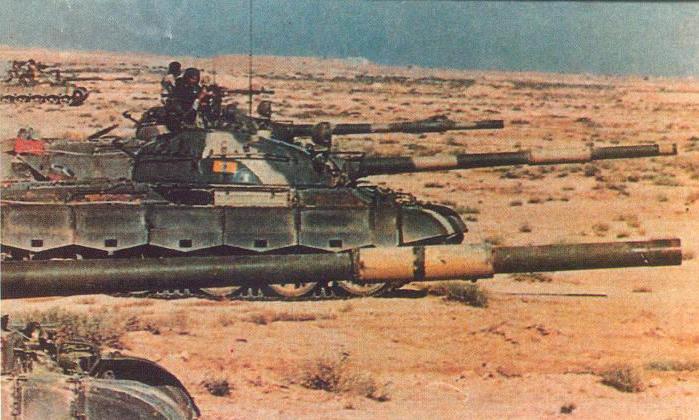 Pan-Arabism and Persophobia graduate from hate literature to violence: T-62 tanks of the Iraqi 6th Armored Division crossing the border into Iran on 1400hrs September 22, 1980. Saddam Hussein and the Baath party were convinced that as their tanks rolled into Khuzestan, they would be greeted as liberators by the Iranian Arabs. This may partly explain why the Iraqis may have miscalculated in the first few days of their invasion of Khuzestan province by not allowing more infantry to accompany their rapid-moving armor (see Iran at War: 1500-1988, 2001, pp.344-355). Instead of being hailed as liberators, Saddam Hussein’s forces were greeted with bitter opposition by the Iranian Arabs whose dogged resistance assisted the overall Iranian effort by slowing down the Iraqi advance (Photo Source: www.Acig.org).
Pan-Arabism and Persophobia graduate from hate literature to violence: T-62 tanks of the Iraqi 6th Armored Division crossing the border into Iran on 1400hrs September 22, 1980. Saddam Hussein and the Baath party were convinced that as their tanks rolled into Khuzestan, they would be greeted as liberators by the Iranian Arabs. This may partly explain why the Iraqis may have miscalculated in the first few days of their invasion of Khuzestan province by not allowing more infantry to accompany their rapid-moving armor (see Iran at War: 1500-1988, 2001, pp.344-355). Instead of being hailed as liberators, Saddam Hussein’s forces were greeted with bitter opposition by the Iranian Arabs whose dogged resistance assisted the overall Iranian effort by slowing down the Iraqi advance (Photo Source: www.Acig.org).
The forces of Saddam Hussein had invaded Iran on September 22, 1980 with the clear aim of severing Iran’s Khuzestan province and joining this to the Baathist Iraqi state. Khorramshahr had fallen under Iraqi occupation on October 26, 1980 after a bloody 35-day house to house battle, Abadan had been besieged, and much Iranian territory remained occupied by Saddam Hussein’s forces.
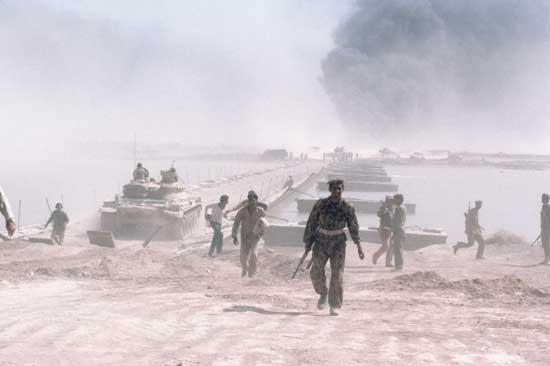 Iraqi troops invading Iran build a pontoon bridge near Khorramshahr in 1981 (Photo source: Francoise de Mulder/Corbis & Encyclopedia Brittanica). The pontoon bridge in the above photo was to be destroyed by Iranian combat aircraft during the May-1982 liberation of Khorramshahr. Numbers of the above troops situated in Khorramshahr in May-1982 were to end up deceased or as P.O.W.s in May 1982.
Iraqi troops invading Iran build a pontoon bridge near Khorramshahr in 1981 (Photo source: Francoise de Mulder/Corbis & Encyclopedia Brittanica). The pontoon bridge in the above photo was to be destroyed by Iranian combat aircraft during the May-1982 liberation of Khorramshahr. Numbers of the above troops situated in Khorramshahr in May-1982 were to end up deceased or as P.O.W.s in May 1982.
Despite the capture of Khorramshahr and the siege of Abadan, Saddam Hussein’s invasion quickly bogged down. The failure to knock out the Iranian land and air forces was to prove dear for Saddam Hussein and the Baathist leadership.
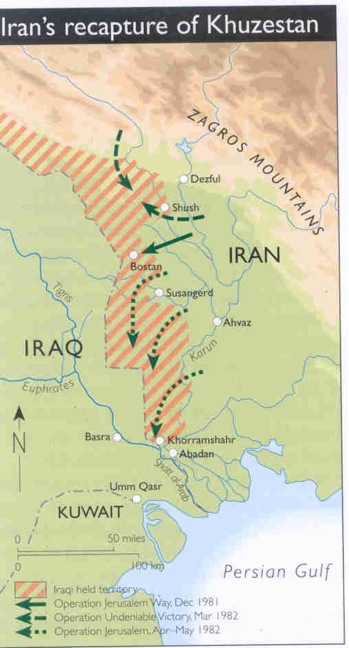 Map of Iranian operations that recaptured Khuzestan (Picture Source: Karsh, E. (2002). The Iran-Iraq War 1980-1988. Osprey Publishing, p.38).
Map of Iranian operations that recaptured Khuzestan (Picture Source: Karsh, E. (2002). The Iran-Iraq War 1980-1988. Osprey Publishing, p.38).
It was from the fall of 1981 when the tide began to turn against Iraqi occupation forces. By September 29th 1981, the right banks of the Karun River had been cleared of Iraqi troops and the siege of Abadan was lifted. A major success soon followed in late-March 1982 with Dehloran liberated. This resulted in Iraqi forces being ejected from the Dezful-Shush region. This set the stage for Iran to implement the final and most devastating stage of its offensives for the ejection of Baathist-Iraqi troops: the liberation of Khorramshahr.
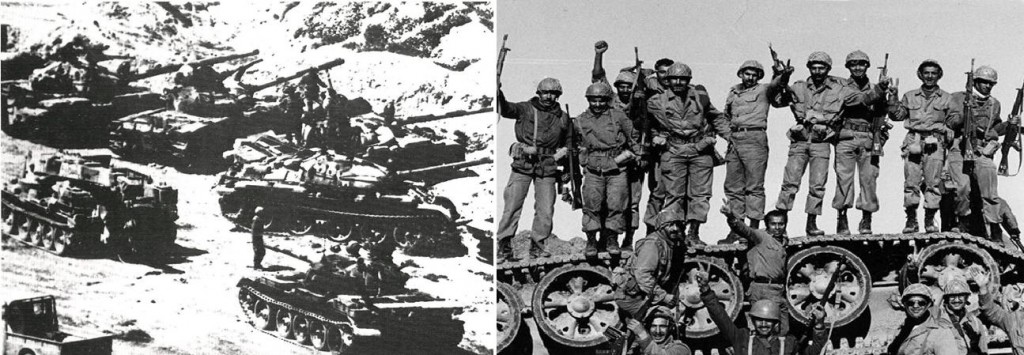 (Left Photo) Elements of the Iraqi 12th Armored Division assemble at Fakkeh (in the Dezful area) on March 23rd 1982 to rescue remnants of the Iraqi 4th Army Corps crushed by a powerful Iranian offensive (Photo source: Steven J. Zaloga, Modern Soviet Combat Tanks, Osprey Vanguard 37, p.32). As these units deployed to attack, they were bombed and strafed by up to 95 Iranian F-4 and F-5 combat aircraft. The Iraqi 12th Armored Division was virtually eliminated. The right photo is of Iranian regular army troops atop an overturned Iraqi tank of the 12th armored division (Photo source: www.shahed.isaar.ir). Note that the vehicle has been blown upside down as a result of aerial bombardment by Iranian F-4 and F-5 combat aircraft.
(Left Photo) Elements of the Iraqi 12th Armored Division assemble at Fakkeh (in the Dezful area) on March 23rd 1982 to rescue remnants of the Iraqi 4th Army Corps crushed by a powerful Iranian offensive (Photo source: Steven J. Zaloga, Modern Soviet Combat Tanks, Osprey Vanguard 37, p.32). As these units deployed to attack, they were bombed and strafed by up to 95 Iranian F-4 and F-5 combat aircraft. The Iraqi 12th Armored Division was virtually eliminated. The right photo is of Iranian regular army troops atop an overturned Iraqi tank of the 12th armored division (Photo source: www.shahed.isaar.ir). Note that the vehicle has been blown upside down as a result of aerial bombardment by Iranian F-4 and F-5 combat aircraft.
It was during the Dezful-Shush operations when the Iranians besieged an Iraqi convoy, unaware that Saddam Hussein was present in that formation. Saddam Hussein was almost captured by Iranian troops but a relief force hurriedly dispatched by Iraqi General Rashid Maher whisked the Iraqi dictator to safety. Despite these defeats and his own recent experience, Saddam Hussein continued to deride his Iranian opponents. In a speech made to the recently battered survivors of the Iraqi fourth army, Saddam stated:
“I hope you will not be bitter about the land you are leaving voluntarily, as dictated by the requirements of defensive positions to the rear…we never told you [the 4th army corps] to keep this land as part of Iraqi land” (From the the archives of the Iraqi News Agency, March 29, 1982; see also citation in Hiro, D. (1990). The Longest War: The Iran-Iraq Military Conflict, Paladin (reprinted by Routledge, 2012), pp.63-64).
This was an interesting statement given that the Iraqi withdrawals had been anything but “voluntary”: they had been militarily forced back with heavy losses during the Iranian military’s clearing of the Dezful-Shush pocket. In addition, Saddam Hussein claimed Iran’s Khuzestan province as part of the pan-Arabist rhetoric of the Baath party.
 Saddam Hussein (right) and Yasser Arafat (left). Arafat had obtained two billion dollars of funds from Iran just a year before Saddam’s army invaded Iran. Many Palestinians fought as volunteers against Iran during the 1980-1988 war, even as revolutionary activists in Tehran were advocating the Palestine issue.
Saddam Hussein (right) and Yasser Arafat (left). Arafat had obtained two billion dollars of funds from Iran just a year before Saddam’s army invaded Iran. Many Palestinians fought as volunteers against Iran during the 1980-1988 war, even as revolutionary activists in Tehran were advocating the Palestine issue.
The loss of Khorramshahr and its tenacious defense had left a profound mark across the Iranian populace. When Iranian forces converged towards Khorramshahr, the combatants included volunteers from across Iran, including Lurs, Azaris, Kurds, Khuzestani-Arabs, Baluchis, etc.
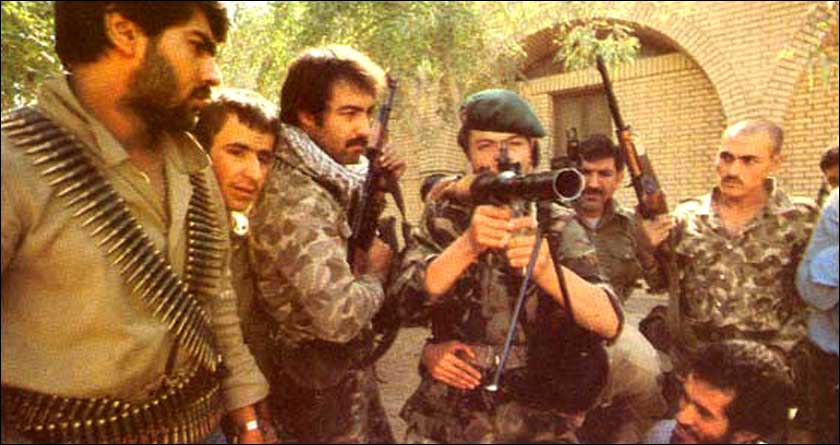 Iranian-Arabs being trained in the use of rocket launcher by an Iranian commando. Iranian Arabs were to later provide assistance to the Iranian army in the ejection of Saddam Hussein’s troops from Khuzestan in 1982.
Iranian-Arabs being trained in the use of rocket launcher by an Iranian commando. Iranian Arabs were to later provide assistance to the Iranian army in the ejection of Saddam Hussein’s troops from Khuzestan in 1982.
When Saddam realized his occupation of Iranian territory was at serious risk, he responded by making a dramatic television visit to his troops in Khorramshahr. When he arrived there he swore to never relinquish the city. Fiery rhetoric however, could do little to prevent the disaster that was about to befall the Iraqi garrison at Khorramshahr. In a sense, Saddam Hussein was to contribute to that disaster, thanks to his rigid (if not draconian) top-down control regimen, which stifled his military’s initiative resulting in a fresh round of military disasters.
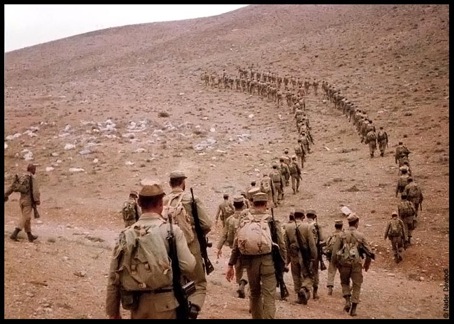 Undated photo of regular Iranian army infantry on the march during the Iran-Iraq war. Thanks to the bitter resistance offered by local militias, Pasdaran and Khuzestan’s Arabs against the Iraqi invasion, the army was given just enough time to re-organize. They were then able to send in just enough combat units to ensure that Ahvaz, Khuzestan’s provincial capital, remained in Iranian hands (Picture Source: Naderdovoodi.net).
Undated photo of regular Iranian army infantry on the march during the Iran-Iraq war. Thanks to the bitter resistance offered by local militias, Pasdaran and Khuzestan’s Arabs against the Iraqi invasion, the army was given just enough time to re-organize. They were then able to send in just enough combat units to ensure that Ahvaz, Khuzestan’s provincial capital, remained in Iranian hands (Picture Source: Naderdovoodi.net).
Preparing the stage: The role of the Iranian Air Force
The Iraqi high command had ordered its French-made Mirage F-1 and Soviet-made MIG-23 jet fighters to be deployed to Iraqi air bases facing Iran. They were apparently hoping to (1) counter Iranian air superiority and (2) Iranian air reconnaissance of Iraqi positions. Recent French deliveries of powerful and technically sophisticated long-range radars were intended to enhance the Iraqi effort at directing their Mirage F-1EQs against Iranian US-manufactured F-14s (Tomcats), F-4s (Phantoms) and F-5s (Tigers).
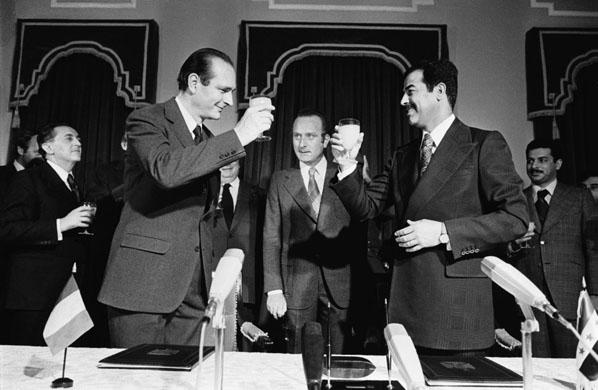 A toast to Saddam’s ambitions. Then Prime Minister Jacques Chirac of France toasts Iraq’s Saddam Hussein on December 1974. By the 1980s, France had become one of Iraq’s biggest military suppliers, especially the Mirage F-1 and other advanced French-made weaponry. This support was so great that French intelligence reported in mid-1986 (after the Iranian capture of Fao) that “…if France cut off the arms pipeline to Iraq for a mere three weeks, Baghdad would collapse” (Timmerman, 1991, p.231 – Timmerman, K.R. (1991). The Death Lobby: How the West Armed Iraq. Houghton-Mifflin Company).
A toast to Saddam’s ambitions. Then Prime Minister Jacques Chirac of France toasts Iraq’s Saddam Hussein on December 1974. By the 1980s, France had become one of Iraq’s biggest military suppliers, especially the Mirage F-1 and other advanced French-made weaponry. This support was so great that French intelligence reported in mid-1986 (after the Iranian capture of Fao) that “…if France cut off the arms pipeline to Iraq for a mere three weeks, Baghdad would collapse” (Timmerman, 1991, p.231 – Timmerman, K.R. (1991). The Death Lobby: How the West Armed Iraq. Houghton-Mifflin Company).
Unfortunately for the Iraqi military brass, the Iranian air force had anticipated these moves. The Iranian air force unleashed a massive air strike on April 4th 1982, specifically targeting Iraqi air bases equipped with the recently delivered Mirage F-1 and MIG-23 fighters. The Iraqis were caught completely off-guard. Iranian jets appeared over key targets at Baghdad, Basra, Kut and Nasseriyah. While estimates vary, between 50-60 Iraqi aircraft were either destroyed on the ground and in air to air combat. Iranian jets continued to pummel military targets in Baghdad into late April. The pounding of Iraqi airfields and suppression of Iraqi aircraft, allowed Iranian RF-4E reconnaissance jets to gather valuable intelligence on Iraqi troop positions and equipment inside Iranian territory. By the time Iranian ground forces were converging on Khorramshahr, Iranian aircraft were dominating the skies over Khuzestan.
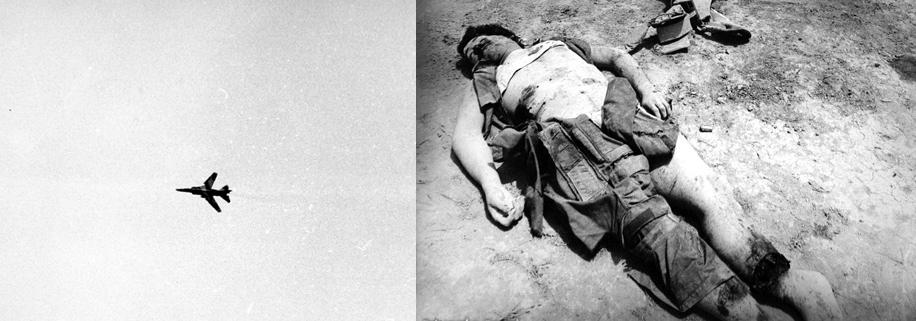 WARNING-GRAPHIC PHOTO (left) An Iraqi Mig-23 just before it was shot down by Iranian forces and (right) remains of its unfortunate pilot after the plane crashed (Picture sources: Military Photos Net). Iraqi Mig-23 aircraft suffered heavy losses at the hands of Iranian F-14s – despite much Soviet-East Bloc, French-Western, Pakistani and Indian assistance, right up to the last days of the war (Picture Source: AviationLive.org).
WARNING-GRAPHIC PHOTO (left) An Iraqi Mig-23 just before it was shot down by Iranian forces and (right) remains of its unfortunate pilot after the plane crashed (Picture sources: Military Photos Net). Iraqi Mig-23 aircraft suffered heavy losses at the hands of Iranian F-14s – despite much Soviet-East Bloc, French-Western, Pakistani and Indian assistance, right up to the last days of the war (Picture Source: AviationLive.org).
The Launch of Operation Bait ol Moghaddas
Iranian forces had deployed to the south of the recently liberated Dezful-Shush region. This was dangerous from Baghdad’s viewpoint as the Iranian army was threatening to cut Iraqi forces in two. The Iranians delivered on this threat by launching a major attack on the night of April 29-30, 1982. Regular army personnel, commandos, and Pasdaran-Baseej militia struck along three axes: Bostan-Susangerd, the west banks of the Karun River and the southwest of Ahwaz.
The Iranian offensive was supported by 200 tanks and 26 AH-1 Cobra gunships. It is not clear how many Iranian tanks were of western origin (American M-47/48/60 and British Chieftain tanks) as by this time the Iranians were also using captured Soviet-made Iraqi equipment. The Iranians also made heavy use of transport helicopters to land their troops on the battlefields. In case of Iraqi air strikes, the Iranians had set up a powerful air defense net of HAWK and Rapier missiles for high and low interception respectively. Making matters worse for Iraqi aircraft was the mass distribution of large numbers of SA-7 shoulder-fired anti-aircraft missiles. Iraqi troops were already under intense pressure as Iranian fighter-bombers were engaged in heavy bombing runs against Iraqi troop concentrations, tank parks and supply lines.
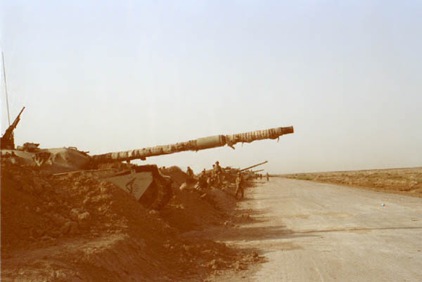 Iranian Chieftain tanks emerging from the side of a road near Khorramshahr in May 1982 (Picture Source: Fars News Agency).
Iranian Chieftain tanks emerging from the side of a road near Khorramshahr in May 1982 (Picture Source: Fars News Agency).
A little know fact about these operations is that Iran set the world record for air transport on May 9, 1982 when their Boeing 747s transported over 6000 fully armed troops of the Khorasan 77th division from Mashad (near the USSR-Afghanistan border in Iran’s northeast) to Khuzestan in a single night. This achievement has received very little attention in the west, where the world record for this type of transport continues to be incorrectly attributed to Israel’s EL AL airlift of 1200 Ethiopian Jews in a single night.
An Iranian Boeing 747-2J9F. Iranian pilots achieved something of a miracle with their Boeing 747s on May 9, 1982 when they transported over 6000 fully armed troops of Khorasan’s 77th infantry division from Mashad (near the USSR-Afghanistan border in Iran’s northeast) to Khuzestan in a single night (Cooper & Bishop, 2000, Iran-Iraq War in the Air, p. 134). This achievement has received little attention in the West, where the world record for this type of transport continues to be incorrectly attributed to the Israeli airlift of 1200 Ethiopian Jews in a single night (Picture Source: p. 31 in “IRIAF: 75th Anniversary review”, World Air Power Journal, Volume 39 Winter 1999 issue, pp.28-37).
The tactics of the Iranian offensive were two-fold. First, infantry assaults backed by tanks were launched against Iraqi forces at night, supported by more tanks and armored personnel carriers the following day. Cobra helicopter gunships wreaked havoc in Iraqi lines as they destroyed large numbers of Iraqi tanks, armored personnel carriers, and soft-skinned vehicles (i.e., trucks, etc.).
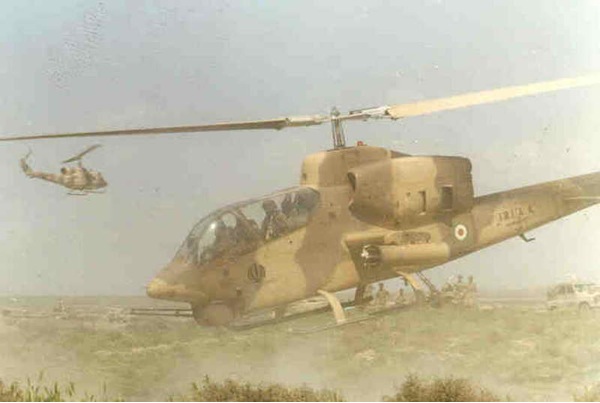 Undated photo of an Iranian Cobra combat helicopter (note Huey-type in background) in action. The Cobra did much to halt Saddam Hussein’s invasion of Iran in 1980 by knocking out scores of Iraqi tanks, armored personnel carriers and other military vehicles. The Cobra distinguished itself again during operations that liberated Iranian territory and up to the last days of the war (Picture Source: Shohada.org).
Undated photo of an Iranian Cobra combat helicopter (note Huey-type in background) in action. The Cobra did much to halt Saddam Hussein’s invasion of Iran in 1980 by knocking out scores of Iraqi tanks, armored personnel carriers and other military vehicles. The Cobra distinguished itself again during operations that liberated Iranian territory and up to the last days of the war (Picture Source: Shohada.org).
Iraqi armor received special attention from the Iranians: the Pasdaran focused their attacks on the already battered elements of the Iraqi 12th armored division.
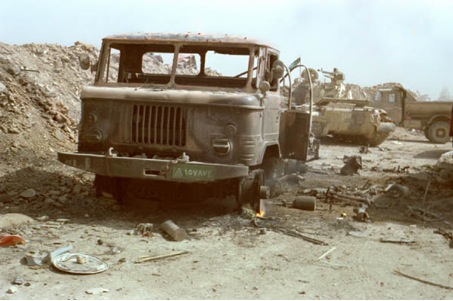 The burnt out chassis of a AIFA East German army truck in Khorramshahr. East Germany like much of the Eastern Bloc, the Soviet Union, the West, India, Brazil and Pakistan provided much military assistance to the Iraqi war effort (Picture Source: Fars News Agency).
The burnt out chassis of a AIFA East German army truck in Khorramshahr. East Germany like much of the Eastern Bloc, the Soviet Union, the West, India, Brazil and Pakistan provided much military assistance to the Iraqi war effort (Picture Source: Fars News Agency).
Iraqi resistance proved highly uneven: regular Iraqi units generally tried to resist but the Popular People’s militias, lacking proper training and morale, often proved eager to surrender when the Iranians attacked.
The results of Iran’s initial attacks against occupying Iraqi troops were devastating. In addition to occupied Iranian territory, the Iraqi military had lost another 100 tanks and two combat helicopters by May 3rd. Perhaps the biggest disaster thus far was the rapid melting of Iraqi units: up to 10,000 Iraqi troops had been captured thus far during these operations.
Now increasingly desperate, Saddam Hussein ordered his jets to challenge the Iranians in the air. This proved to be an impulsive decision: Iran’s F-4 and F-14 fighters shot down up to 50 Iraqi aircraft at the cost of four F-4s and three helicopters. Saddam finally relented to the advice of his generals who pleaded with him to withdraw what was left of the Iraqi air fleet on May 5-6. The Iranian advance towards Khorramshahr was now assured of complete air superiority. For air support, the Iraqis were now forced to rely on their helicopters.
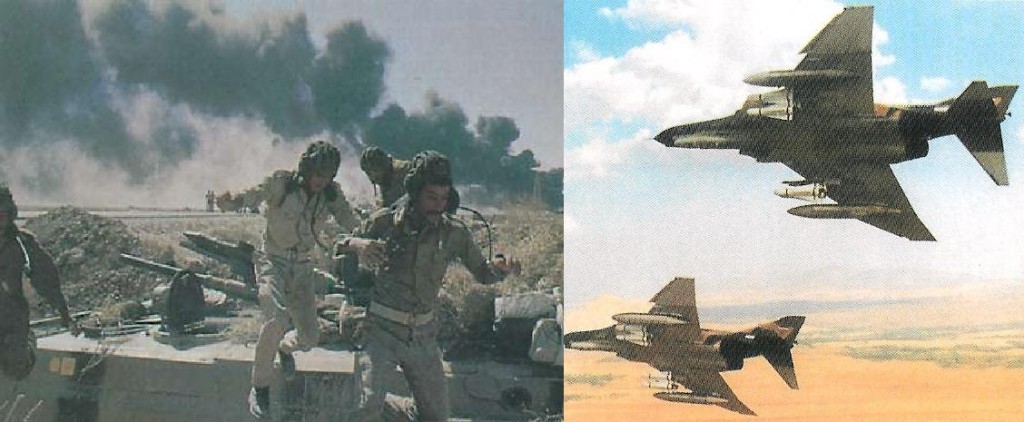 Tayyara! Tayyara! (Arabic: Airplane! Airplane!). Iraqi crew of a BMP armored peronnel carrier advancing in Iran in 1980 (at left) abandon their vehicle in haste at the sound of the roaring engines of two US-made Iranian F-4E Phantoms. Iranian Phantoms (at right) were also reported to be flying just meters above ground level to fire their 20mm cannon at Iraqi tanks and armored vehicles (Picture Source at left: www.Acig.org; Picture Source at right: Farzad Bishop, Combat Aircraft 37, reproduced with permission in Iran at War: 1500-1988, 2011).
Tayyara! Tayyara! (Arabic: Airplane! Airplane!). Iraqi crew of a BMP armored peronnel carrier advancing in Iran in 1980 (at left) abandon their vehicle in haste at the sound of the roaring engines of two US-made Iranian F-4E Phantoms. Iranian Phantoms (at right) were also reported to be flying just meters above ground level to fire their 20mm cannon at Iraqi tanks and armored vehicles (Picture Source at left: www.Acig.org; Picture Source at right: Farzad Bishop, Combat Aircraft 37, reproduced with permission in Iran at War: 1500-1988, 2011).
After a series of highly-publicized TV propaganda programs aimed at the Arabo-Islamic world and the west ridiculing the Iranian military, the Iraqi military leadership seems to have finally realized what was happening. Saddam unleashed his remaining tanks in Iran to launch a powerful counterattack on May 3-4; this enjoyed some success and some Iranian ground was again taken. Unfortunately for Saddam Hussein and the Iraqi military, the Iranian commander in the theater, Ali Sayad Shirazi, had already predicted this attack. Once the Iraqi counterattack had been spent, Shirazi ordered a major thrust towards the border town of Fakkeh, which the Iranians quickly captured.
Iranian helicopters also landed the 55th Para brigade in the Iraqi border town of Shalamcheh in Iraq’s Basra province. The landing had been provided air cover by Iranian F-4 and F-5 fighters. Meanwhile, Iranian Cobra gunships also participated by destroying Iraqi armor, bridges and combat vehicles at Shalamcheh.
The fall of Shalamcheh was another shock for Baghdad as Iranian troops were now just 26-27 kilometers from Basra. This also signaled that remaining Iraqi forces occupying Iranian territory were increasingly isolated. The only way for the Iraqi army to rescue their faltering situation was to push the Iranians out of Fakkeh and Shalamcheh, but the unraveling military situation prevented this action. Saddam Hussein however refused to give up. He and the Baathist leadership held on to their pan-Arabist vision of annexing Khuzestan province.
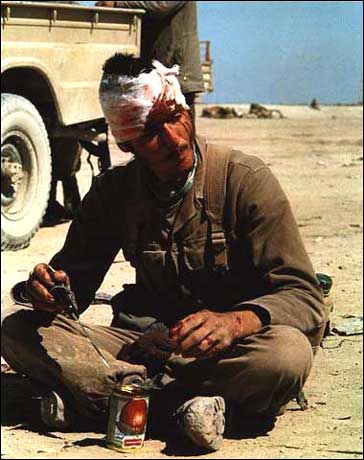 Undated photo of a wounded Iranian soldier resting during a pause in the fighting (Picture Source: Mannaismayaadventure).
Undated photo of a wounded Iranian soldier resting during a pause in the fighting (Picture Source: Mannaismayaadventure).
Saddam and the Iraqi high command were to receive more bad news. Just six days after their failed May 3rd counterattack, the Pasdaran tore a wide gap in the Iraqi lines. This attack was followed by a tank thrust by the 92nd Iranian armored division. The result of the 92nd armored division’s attack was devastating: two entire Iraqi army divisions, including the 6th armored division had been wiped out. The 92nd then wheeled towards Shalamcheh to link up with the 55th paras inside the town.
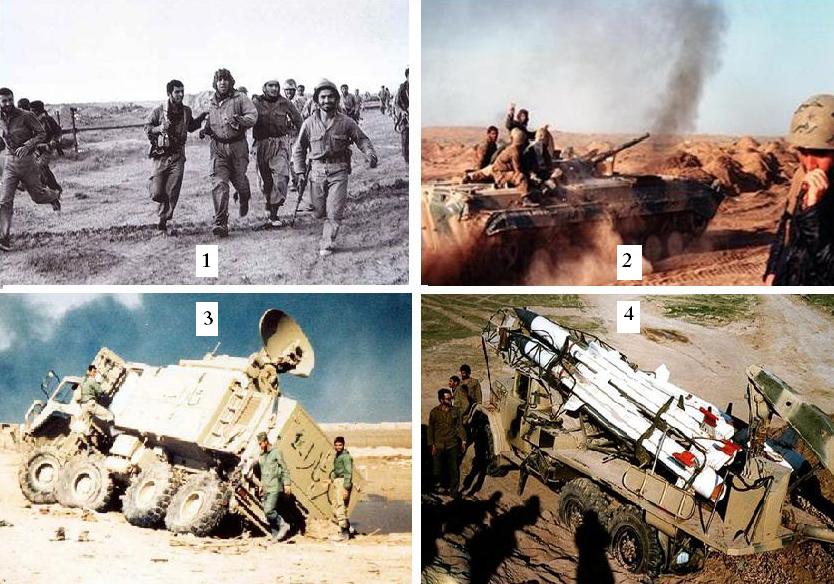 Some scenes from the Iran-Iraq war (1980-1988): [1] Demoralized Iraqi army tank crew surrenders just north of Khorramshahr as Iranian troops take positions to liberate the city (Picture Source: Military Photos) [2] Ex-Iraqi BMP armored personnel carriers being used by the Iranians against their former owners (Picture Source:Shahed) [3] A captured Iraqi French-made ROLAND low-altitude anti-aircraft missile system at Fao in February 1986 (Picture source:Military Photos) [4] Iranian troops transport captured Iraqi SAM missiles in the aftermath of the expulsion of occupying Iraqi forces from Khuzestan in May-June 1982 (Picture source:Military Photos).
Some scenes from the Iran-Iraq war (1980-1988): [1] Demoralized Iraqi army tank crew surrenders just north of Khorramshahr as Iranian troops take positions to liberate the city (Picture Source: Military Photos) [2] Ex-Iraqi BMP armored personnel carriers being used by the Iranians against their former owners (Picture Source:Shahed) [3] A captured Iraqi French-made ROLAND low-altitude anti-aircraft missile system at Fao in February 1986 (Picture source:Military Photos) [4] Iranian troops transport captured Iraqi SAM missiles in the aftermath of the expulsion of occupying Iraqi forces from Khuzestan in May-June 1982 (Picture source:Military Photos).
By mid-May the Iraqis had lost more tanks, troops and territory just north of Khorramshahr. The loss of all land routes to Khorramshahr tightened the noose around the city’s occupying Iraqi troops. The situation of the Iraqi garrison at Khorramshahr now resembled that of the German 6th army at Stalingrad when it became surrounded by Soviet forces in November 1942.
Saddam’s “Wall of the Persians”
To defend Khorramshahr against Iranian attacks, the 35,000-man Iraqi garrison had built three fortified tiers of minefields and earthworks, which they christened as “The Wall of the Persians”. By now the Iraqis had learned to take the threat of Iranian commando landings seriously. These fears prompted the Iraqi garrison to erect a large number of metal spikes in areas deemed most vulnerable to helicopter or parachute landings. One of the most dramatic tactics they devised was to place hundreds of derelict cars in an upright position to bolster these “anti-commando” defenses!
By May 21st, the Iranians had firmly placed 70,000 troops around Khorramshahr. Saddam Hussein again refused to budge, but no amount of passionate rhetoric could turn the tide.
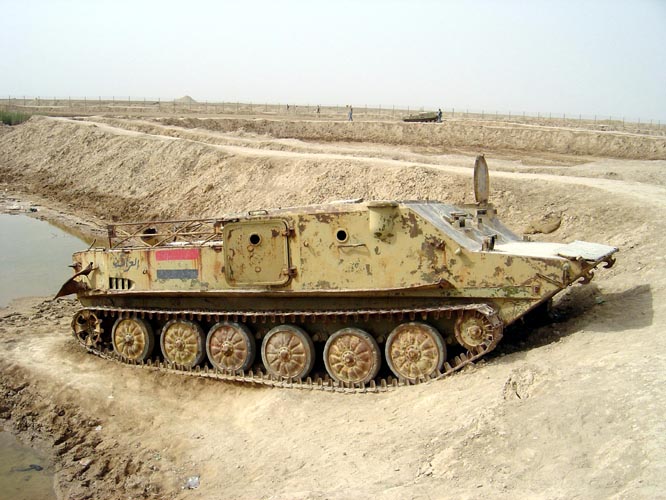 [Click to Enlarge] An abandoned Iraqi BTR 50 Soviet-built APC (armored personnel carrier). By this time scores of Iraqi tanks and APCs were being abandoned due to fears of Iranian fighter aircraft, Cobra combat helicopters and ground troops, now lavishly equipped with lethal anti-tank weapons. Another factor contributing to Iraqi armored losses was inadequate training. Before the war, the primary combat experience of Iraqi armored crews had been against the poorly armed Iraqi-Kurdish militias of northern Iraq (Picture Source: Public Domain).
[Click to Enlarge] An abandoned Iraqi BTR 50 Soviet-built APC (armored personnel carrier). By this time scores of Iraqi tanks and APCs were being abandoned due to fears of Iranian fighter aircraft, Cobra combat helicopters and ground troops, now lavishly equipped with lethal anti-tank weapons. Another factor contributing to Iraqi armored losses was inadequate training. Before the war, the primary combat experience of Iraqi armored crews had been against the poorly armed Iraqi-Kurdish militias of northern Iraq (Picture Source: Public Domain).
Khorramshahr Liberated
The Iraqi garrison had only one lifeline for securing its supplies: the Arvand Rud/Shaat al Arab waterway. But even this last lifeline was under threat: the Iranian air force was now running constant patrols over the waterway. Iranian jets destroyed all bridges across the waterway and sank any Iraqi vessels daring to bring supplies into Khorramshahr. To make matters worse, Iranian heavy artillery began pounding the Iraqi garrison. These same guns also shelled Iraqi supply lines along the waterway.
The attack came sooner than Saddam had expected; the Iranians struck on the night of May 23rd. Even before the Iranian army rolled into Khorramshahr, the Iraqi garrison was being subjected to heavy artillery and air strikes.
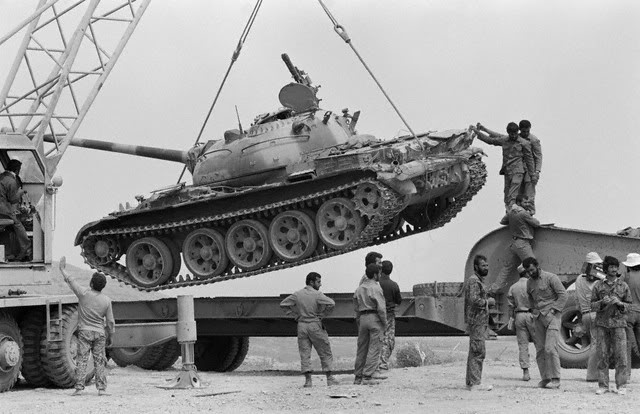 [Click to Enlarge] Captured Iraqi T-55 tank being loaded onto a heavy truck by Iranian forces as they converge towards Khorramshahr (Picture Source: MilitaryPhotos.net). Perhaps one of the biggest ironies of the war is that the Iranians often relied on battlefield captures to help replenish their own dwindling stocks of tanks.
[Click to Enlarge] Captured Iraqi T-55 tank being loaded onto a heavy truck by Iranian forces as they converge towards Khorramshahr (Picture Source: MilitaryPhotos.net). Perhaps one of the biggest ironies of the war is that the Iranians often relied on battlefield captures to help replenish their own dwindling stocks of tanks.
The Iranian strike into Khorramshahr was composed of the 77th Khorasan division, the 59th Zolfaqhar brigade, and the Pasdaran. Saddam’s much publicized “Wall of the Persians” proved to be more of a propaganda ploy that an effective military deterrent. As soon as Iranian troops entered Khorramshahr’s environs, 4000 Iraqi troops immediately surrendered.
Constant defeats over the months in 1982 had taken a terrible toll of Iraqi morale. The Iraqi garrison at Khorramshahr had little motivation to die for Saddam Hussein to the bitter end. Two thirds of the Iraqi garrison, 22,000 men (15,000 regular army and the rest being the people’s army), chose to surrender as the Iranians liberated Khorramshahr street by street. With the conclusion of operation Beit ol Moghaddas, Iraq had lost 33-35,000 of its combatants as prisoners.
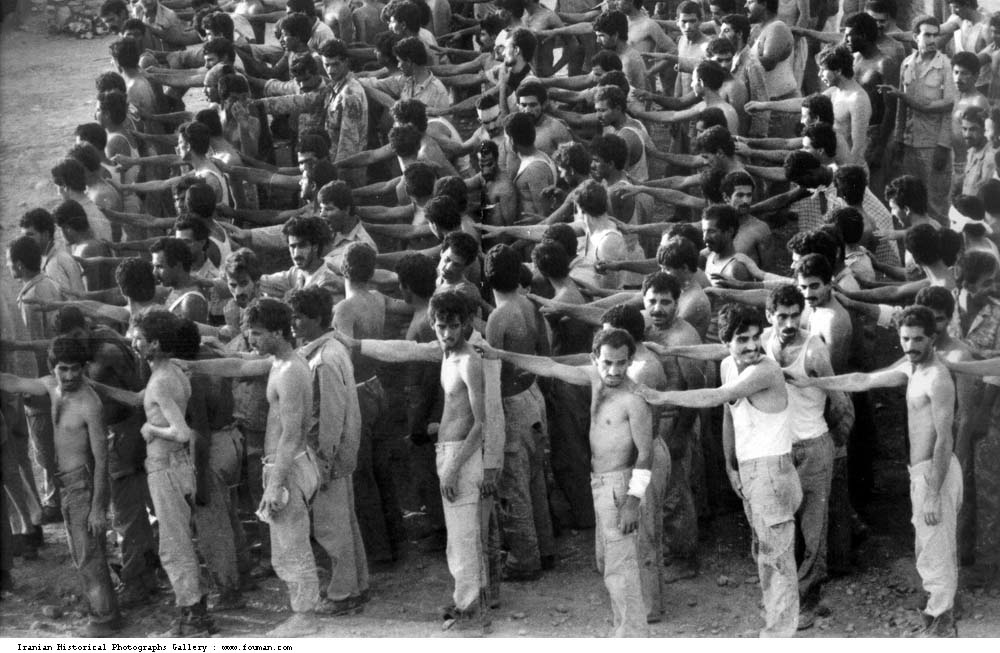 The Aftermath: Iraqi P.O.W.s rounded up for internment after the liberation of Khorramshahr. Morale among ordinary Iraqi ranks was often low during the war which may partly explain the relatively large numbers of P.O.W.s yielded by Iraqi forces during the war. As the war progressed “Iraqi” prisoners were to include Palestinians, Egyptians, Sudanese, Pakistanis, Jordanians, etc. (Picture Source: Fouman: Iranian Historical Photographs Gallery).
The Aftermath: Iraqi P.O.W.s rounded up for internment after the liberation of Khorramshahr. Morale among ordinary Iraqi ranks was often low during the war which may partly explain the relatively large numbers of P.O.W.s yielded by Iraqi forces during the war. As the war progressed “Iraqi” prisoners were to include Palestinians, Egyptians, Sudanese, Pakistanis, Jordanians, etc. (Picture Source: Fouman: Iranian Historical Photographs Gallery).
It remains unclear as to how many of the surviving 13,000 Iraqi troops managed to escape across the Arvand Rud/Shaat al Arab waterway to Iraq. What is clear is that the Iraqi withdrawal had been characterized by panic and chaos (see for example below).
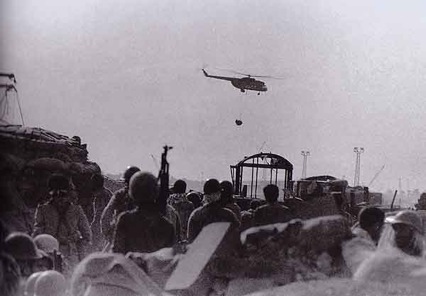 An Iraqi helicopter bringing in supplies for the Iraqi garrison at Khorramshahr, evidently unaware that the city had already fallen to Iranian troops. As soon as the unfortunate helicopter arrived, it was shot down and forced to land by Iranian troops. The Iraqi helicopter crew was then taken prisoner. The scene was displayed by western news outlets as they were reporting on the fighting in Khorramshahr (Picture source: Military Photos).
An Iraqi helicopter bringing in supplies for the Iraqi garrison at Khorramshahr, evidently unaware that the city had already fallen to Iranian troops. As soon as the unfortunate helicopter arrived, it was shot down and forced to land by Iranian troops. The Iraqi helicopter crew was then taken prisoner. The scene was displayed by western news outlets as they were reporting on the fighting in Khorramshahr (Picture source: Military Photos).
The cost of liberating Khorramshahr had certainly been steep for Iran: over 6000 combatants had lost their lives during these operations with at least another 24,000 injured.
Epilogue: A Little Known Fact
Less known is the fact that Saddam Hussein narrowly escaped death during the Iranian liberation of Khorramshahr. Saddam had been directing Iraqi operations from a bunker near Shalamcheh where the “Pontoon of Saddam” had been rapidly set up. Saddam’s bunker suffered a deadly air strike by Iranian fighter-bombers, unaware of the distinguished staff at the receiving end of their bombs. The bombing strike may have injured Saddam, although such reports remain unconfirmed. What is certain is that by this stage of the war, Iran had liberated 5,400 square kilometers of its territory from the Iraqis. The city of Khorramshahr had been finally avenged 575 days after its fall to Saddam Hussein’s troops.
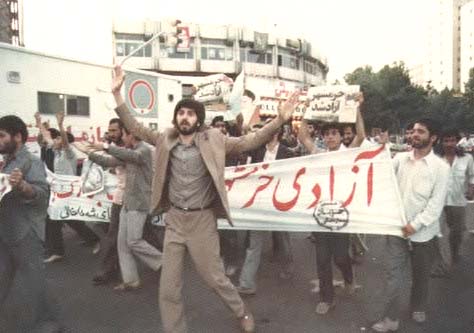 Citizens of Tehran celebrate the liberation of Khorramshahr (Picture Source: Iranian.com).
Citizens of Tehran celebrate the liberation of Khorramshahr (Picture Source: Iranian.com).





